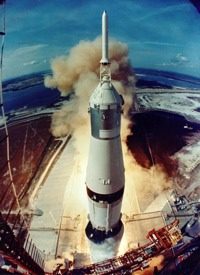
As millions of Americans remember “where they were” 40 years ago when they first heard Neil Armstrong’s famous first words from the surface of the moon, the nation is poised between different possible futures for manned space exploration.
Just in time for the fortieth anniversary of the first manned moon landing, NASA’s Lunar Reconnaissance Orbiter (LRO) returned images of five of the Apollo landing sites, including the Apollo 11 site. The arrival of the LRO in lunar orbit on June 23 highlights the mixed message of America’s ongoing efforts to explore the heavens. The LRO demonstrates one step in a renewed commitment to the exploration of the moon. But there is also a poignancy to viewing the LRO images: two generations after the first Apollo landing, we can now see what was once done but the nation can not presently repeat the deeds of a prior generation.
The moon landing was a goal shared by men across many generations; for example, Anglican Bishop John Wilkins, one of the founders of the Royal Society, wrote in his 1638 book, A World in the Moon: “In the first ages of the world the Islanders either thought themselves to be the only dwellers upon the earth, or else if there were any other, yet they could not possibly conceive how they might have any commerce with them, being severed by the deepe and broad Sea, but the after-times found out the invention of ships, in which notwithstanding none but some bold daring men durst venture, there being few so resolute as to commit themselves unto the vast Ocean, and yet now how easy a thing is this, even to a timorous & cowardly nature? So, perhaps, there may be some other means invented for a conveyance to the Moon, and though it may seem a terrible and impossible thing ever to pass through the vast spaces of the air, yet no question there would be some men who durst venture this as well as the other.”
The exercise of such courage and vision fell to the people of the United States of America living in the midst of the anxieties of the Cold War and contending with the nihilism and selfishness that held so many in the sway in the counter culture of the 1960s.
It was to the age of Wilkins and America’s Puritan forefathers that President Kennedy appealed on September 12, 1962 when he advocated sending a manned mission to the moon: “William Bradford, speaking in 1630 of the founding of the Plymouth Bay Colony, said that all great and honorable actions are accompanied with great difficulties, and both must be enterprised and overcome with answerable courage.” It was to such “great and honorable actions” President Kennedy called his nation: “Those who came before us made certain that this country rode the first waves of the industrial revolutions, the first waves of modern invention, and the first wave of nuclear power, and this generation does not intend to founder in the backwash of the coming age of space. We mean to be a part of it — we mean to lead it. For the eyes of the world now look into space, to the moon and to the planets beyond, and we have vowed that we shall not see it governed by a hostile flag of conquest, but by a banner of freedom and peace. We have vowed that we shall not see space filled with weapons of mass destruction, but with instruments of knowledge and understanding. Yet the vows of this Nation can only be fulfilled if we in this Nation are first, and, therefore, we intend to be first. In short, our leadership in science and in industry, our hopes for peace and security, our obligations to ourselves as well as others, all require us to make this effort, to solve these mysteries, to solve them for the good of all men, and to become the world’s leading space-faring nation.”
Remembering the events of 40 years ago, Neil Armstrong remembered the courageous personal sacrifices that men made for the sake of the vision of men traveling to another world, pausing to commemorate the three astronauts of Apollo 1 — Ed White, Virgil Grissom, Roger Chaffee — who died in January 27, 1967 during a fire which occurred during routine tests of Apollo’s systems. Their sacrifice would not be the last: the space shuttle Challenger exploded on January 28, 1986 with the loss of seven astronauts, and another seven were lost on February 1, 2003 when the Columbia disintegrated during reentry.
Since the end of the Apollo era, NASA has often seemed to lose its way due to the fixation on institutional survival which plagues any bureaucracy. Often the International Space Station looks more like a cross between a “money pit” and an experiment in international handholding gone very, very wrong. Nevertheless, the scientific study of the heavens has continued despite tragedies and bureaucratic bungling; the “ninety-day” missions of two Mars rovers, Spirit and Opportunity, have continued for nearly five and a half years — a testimony to the skills of the men and women involved in their development and support. The phenomenal success of the Hubble space telescope has yielded not merely breathtaking images of the heavens, but a stunning increase in scientific knowledge of the heavens.
Much of the work of the post-Apollo space program has been accomplished despite the lack of a destination-driven program such as in place in the 1960s. On May 7, President Obama established the “Augustine Commission” (so-called for its chairman, Norman Augustine, former CEO of Lockheed Martin) to evaluate various possibilities for human exploration in space. At the same time, what may prove to be the most promising prospects for human exploration of the heavens are being undertaken by private companies. For example, SpaceX, established by Paypal founder Elon Musk in 2002, successfully launched a commercial satellite on July 13 and is presently developing the Dragon capsule which will be capable of carrying cargo and crew into space, independent of any government agency.
Those who would claim the destination-driven missions of the age of Apollo were a waste of money might just as well say the same of the Lewis and Clark expedition (1803-1806) or go on mocking “Seward’s Folly” of negotiating the acquisition of the territory of Alaska for the United States.
Advances in private, corporate launch capacity holds out the hope of replacing much of the mission of the space shuttle with profitable space craft. As with the settling of the “New World” and the exploration of the American West, the first expeditions were undertaken by various governments. What mattered, from the standpoint of the generations who inhabit the lands which were once terra incognita is that those first expeditions were followed by countless thousands of men and women whose names are forgotten by history, but whose courage reflected that of the first explorers, as they staked all that they were and all that they had to build a new life. Such self-sacrifice is part of our heritage, and it is a legacy to be handed down to the generations to come in a new frontier.



